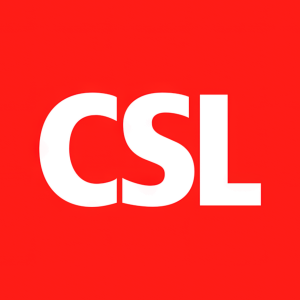CSL Announces Positive Preclinical Data for Self-Amplifying Messenger RNA (sa-mRNA) Influenza Vaccine Candidates
Rhea-AI Summary
CSL announced positive preclinical results for its self-amplifying mRNA (sa-mRNA) influenza vaccine candidates, showing a strong immune response against A(H5N1) and A(H1N1) strains. Published in Molecular Therapy – Methods and Clinical Development, the study indicated that a low dose (0.01 µg) of the A(H5N1) candidate induced significant antibody production and T-cell responses. CSL plans to initiate Phase 1 clinical trials soon, highlighting the sa-mRNA technology's potential to enhance vaccine efficacy and reduce doses required during pandemic settings.
Positive
- Preclinical studies show sa-mRNA influenza vaccine candidates induce strong immune responses.
- A(H5N1) candidate demonstrated efficacy at a low dose of 0.01 µg in preclinical models.
- Sa-mRNA technology might enable more effective vaccines with lower dosage requirements.
Negative
- None.
Insights
Analyzing...
Data published in Molecular Therapy – Methods and Clinical Development confirm the potential preclinical benefit of the sa-mRNA technology platform, the next generation of mRNA vaccine technology
CAMBRIDGE, Mass., Oct. 5, 2022 /PRNewswire/ -- Global biotech leader CSL (ASX:CSL) today announced results from the preclinical studies of the company's self-amplifying messenger RNA (sa-mRNA) influenza vaccine candidates, the next generation of mRNA vaccines. The data, published in Molecular Therapy – Methods and Clinical Development, indicate that the sa-mRNA influenza vaccine candidates produced a potent, cross-reactive immune response against pandemic and seasonal influenza strains, A(H5N1) and A(H1N1).1
"These preclinical data show the potential of sa-mRNA technology to provide protection against pandemic and seasonal influenza in one vaccine dose," said Ethan Settembre, PhD, Vice President, Research, CSL R&D Seqirus Vaccines Innovation Unit and study author. "As we look toward initiating our Phase 1 clinical trials in the near future, these data are an encouraging testament to the value of pursuing innovative vaccine technology platforms, like sa-mRNA."
mRNA vaccines help protect against infectious diseases by giving instructions to cells in the body to make a protein, stimulating the immune response and leaving a blueprint to recognize and fight future infection.2 Different from standard mRNA vaccines, sa-mRNA instructs the body to replicate mRNA, amplifying the amount of protein made.3 This could enable vaccine manufacturers to potentially develop more effective vaccines with a smaller dosage and with lower rates of reactogenicity, underscoring the value in both pandemic and seasonal settings.3
"In addition to the burden of seasonal influenza, emerging pandemic pathogens remain an ever-present threat and the need for flexible, effective vaccine technology is clearer than ever," said Jonathan Edelman, MD, Vice President, Vaccines Clinical Development, Interim Head, CSL R&D Seqirus Vaccines Innovation Unit. "As we continue actively pursuing technological advances to improve influenza protection and strengthen our differentiated vaccine portfolio, the data published in Molecular Therapy – Methods and Clinical Development allows for a better understanding of the potential of sa-mRNA vaccine technology."
As a global leader in influenza prevention, CSL Seqirus' longstanding heritage in influenza vaccines, along with CSL R&D's established capabilities in vaccine research and clinical development, positions CSL well to make strategic investments in both the development of the company's existing platforms and in longer-term, high opportunity development activities. While influenza is at the core of the CSL Seqirus business, the company is also exploring the potential for sa-mRNA vaccines in other infectious disease areas.
CSL Seqirus produces influenza vaccines across its global manufacturing network, which includes facilities in the U.S., U.K. and Australia. In February 2022, CSL Seqirus announced an investment in a new R&D facility located in Waltham, Mass. The new facility will support the company's growing R&D portfolio, with a focus on the sa-mRNA technology platform. The facility will serve as the company's central R&D hub for current and future vaccine design, and collaborations with stakeholders from across the industry and academia.
About the Study
The preclinical studies were designed to evaluate the ability of sa-mRNA bicistronic influenza vaccine candidates, A(H5N1) and A(H1N1) to co-express two influenza antigens, hemagglutinin (HA) and neuraminidase (NA), raising potent immune responses in mice and ferrets.1 While HA has been the primary protein included in licensed inactivated influenza vaccine formulations, NA is the second most abundant influenza surface protein, and the bicistronic capability, incorporated in this sa-mRNA influenza vaccine study for the first time, unlocked the possibility to produce both HA and NA antigens.1
The results demonstrate that the A(H5N1) sa-mRNA influenza vaccine candidate induced an anti-HA and anti-NA neutralizing response raised by sa-mRNA influenza vaccines at a dose as low as 0.01 µg in mice and also induced HA-specific CD4+ T cells.1 In comparison to the MF59®-adjuvanted influenza vaccine and non-adjuvanted protein vaccine, the adjuvanted influenza vaccine also raised CD4+ T cell response, while the non-adjuvanted protein vaccine did not.1 sa-mRNA vaccines also stimulated CD8+ T cell response, an effect which was not exhibited in both non-adjuvanted and adjuvanted protein vaccines.1
The bicistronic A(H1N1) vaccine candidate protected the ferrets' lungs from influenza infection by markedly reducing the amount of virus in the ferrets' upper respiratory tract.1
Due to the additional NA antigen, bicistronic A(H5N1) vaccines not only raised a potent neutralizing response to pandemic A(H5N1), but also to A(H1N1) and produced cross-reactive humoral and cellular responses in mice and ferrets.1 NA demonstrated a notable immune response without compromise of the immune response to HA raised by our sa-mRNA bicistronic influenza vaccines.1 The meaningful and cross-reactive immune responses raised by the sa-mRNA influenza vaccine candidates resulted in protection from influenza infection.1
Read the full manuscript here.
About Seasonal Influenza
Influenza is a common, contagious seasonal respiratory disease that may cause severe illness and life-threatening complications in some people.4 Influenza can lead to clinical symptoms varying from mild to moderate respiratory illness to severe complications, hospitalization and in some cases, death.4 Because transmission of influenza viruses to others may occur one day before symptoms develop and up to 5 to 7 days after becoming sick, the disease can be easily transmitted to others.4 Estimates from the Centers for Disease Control and Prevention (CDC) report that during the 2019/20 influenza season, there were an estimated 405,000 influenza-related hospitalizations in the U.S.5 The CDC recommends annual vaccination for individuals aged 6 months and older, who do not have any contraindications.6 Since it takes about two weeks after vaccination for antibodies to develop in the body that help protect against influenza virus infection, it is recommended that people get vaccinated before influenza begins spreading in their community.6 The CDC recommends that people get vaccinated by the end of October.6
About Pandemic Influenza
Pandemic influenza, is a contagious airborne respiratory disease which is unpredictable in timing and severity.7 The risk of influenza-associated morbidity and mortality is greater with pandemic influenza than with seasonal influenza because there is likely to be little or no pre-existing immunity to the virus in the human population.8 Four influenza pandemics have occurred over the past century, with the 1918 pandemic being the most severe in recent history, estimated to have killed up to 50 million people worldwide.9 According to the CDC, a novel influenza A virus such as the highly pathogenic avian A(H5N1) strain can cause severe disease and have a high mortality rate.10 If the influenza A(H5N1) virus were to change and become easily transmissible from person to person while retaining its capacity to cause severe disease, the consequences for public health could be severe.10
About CSL
CSL (ASX:CSL; USOTC:CSLLY) is a leading global biotechnology company with a dynamic portfolio of lifesaving medicines, including those that treat haemophilia and immune deficiencies, vaccines to prevent influenza, and therapies in iron deficiency, dialysis and nephrology. Since our start in 1916, we have been driven by our promise to save lives using the latest technologies. Today, CSL – including our three businesses, CSL Behring, CSL Seqirus and CSL Vifor – provides lifesaving products to patients in more than 100 countries and employs 30,000 people. Our unique combination of commercial strength, R&D focus and operational excellence enables us to identify, develop and deliver innovations so our patients can live life to the fullest. For inspiring stories about the promise of biotechnology, visit CSLBehring.com/Vita and follow us on Twitter.com/CSL.
For more information about CSL, visit www.CSL.com.
About CSL Seqirus
CSL Seqirus is part of CSL Limited (ASX: CSL). As one of the largest influenza vaccine providers in the world, CSL Seqirus is a major contributor to the prevention of influenza globally and a transcontinental partner in pandemic preparedness. With state-of-the-art production facilities in the U.S., the U.K. and Australia, and leading R&D capabilities, CSL Seqirus utilizes egg, cell and adjuvant technologies to offer a broad portfolio of differentiated influenza vaccines in more than 20 countries around the world. For more information about CSL Seqirus, visit www.seqirus.com.
Media Contact
CSL Seqirus
Polina Miklush
Office: +1 908 608 7170
Email: Polina.Miklush@Seqirus.com
References
1 Chang C, Music N, Cheung M, et al. Influenza sa-mRNA bicistronic HANA vaccines raise potent and cross-reactiveneutralizing antibody and cell-mediated immune responses in mice. Molecular Therapy – Methods and Clinical Development. DOI: 10.1016/j.omtm.2022.09.013.
2 Centers for Disease Control and Prevention (CDC). (2022). Understanding mRNA COVID-19 Vaccines. Retrieved from: https://www.cdc.gov/coronavirus/2019-ncov/vaccines/different-vaccines/mrna.html. Accessed September 2022.
3 Vigel, B., Lambert, L., Kinnear, E., et al. (2018). Self-Amplifying RNA Vaccines Give Equivalent Protection against Influenza to mRNA Vaccines but at Much Lower Doses. American Society of Gene & Cell Therapy.
4 CDC. (2022). Key Facts about Influenza. Retrieved from https://www.cdc.gov/flu/about/keyfacts.htm. Accessed September 2022.
5 CDC. (2021). Estimated Influenza Illnesses, Medical visits, Hospitalizations, and Deaths in the United States – 2019-2020 Influenza Season. Retrieved from: https://www.cdc.gov/flu/about/burden/2019-2020.html. Accessed September 2022.
6 CDC. (2022). Who Needs a Flu Vaccine and When. Retrieved from: https://www.cdc.gov/flu/prevent/vaccinations.htm. Accessed September 2022.
7 CDC. (2016). Pandemic Basics. Retrieved from: https://www.cdc.gov/flu/pandemic-resources/basics/index.html. Accessed September 2022.
8 WHO. (2014). How pandemic influenza emerges. Retrieved from: https://www.who.int/europe/news-room/fact-sheets/item/how-pandemic-influenza-emerges. Accessed September 2022.
9 WHO. (2017). Pandemic Influenza Risk Management: A WHO guide to inform and harmonize national and international pandemic preparedness and response. Retrieved from: https://apps.who.int/iris/bitstream/handle/10665/259893/WHO-WHE-IHM-GIP-2017.1-eng.pdf;jsessionid=4421F16879D2F8B96481F8D0C745C7F3?sequence=1. Accessed September 2022.
10 CDC. (2015). Highly Pathogenic Asian Avian Influenza A(H5N1) in People. Retrieved from: https://www.cdc.gov/flu/avianflu/h5n1-people.htm. Accessed September 2022.
![]() View original content:https://www.prnewswire.com/news-releases/csl-announces-positive-preclinical-data-for-self-amplifying-messenger-rna-sa-mrna-influenza-vaccine-candidates-301641467.html
View original content:https://www.prnewswire.com/news-releases/csl-announces-positive-preclinical-data-for-self-amplifying-messenger-rna-sa-mrna-influenza-vaccine-candidates-301641467.html
SOURCE CSL Seqirus






